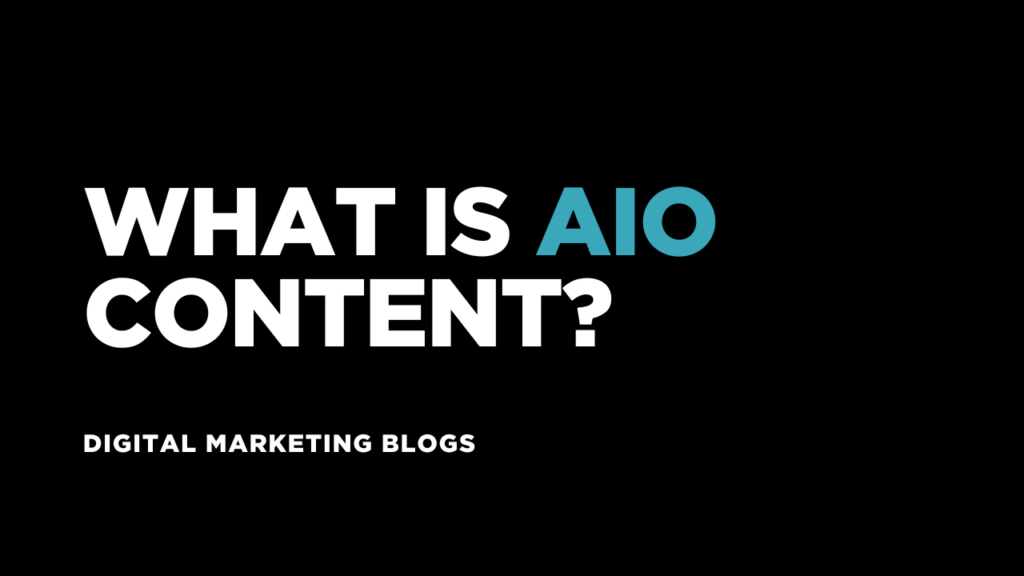Introduction
As search engines evolve, traditional SEO strategies are no longer enough to stay competitive. One concept rapidly gaining attention is AIO content. This term stands for Artificial Intelligence Optimized content, a strategy built for the age of smart algorithms, AI search, and user intent.
In this blog, we’ll explore what AIO content really is, how it differs from traditional SEO content, and why it’s becoming essential for rankings in 2025. Whether you’re a blogger, business owner, or a digital marketer in Calicut, this guide will help you understand and implement AIO content effectively.
What is AIO Content?
AIO content refers to web content that is not only optimized for keywords and user engagement but also aligned with AI-driven search engines and their priorities. These AI systems—such as Google’s Search Generative Experience (SGE), Bing AI, and ChatGPT—use natural language processing, machine learning, and semantic understanding to provide the most accurate, helpful, and context-aware results.
Unlike traditional SEO, which was heavily reliant on keywords, backlinks, and metadata, AIO content prioritizes:
-
Topical authority
-
Content structure and clarity
-
User intent
-
Data accuracy
-
Human-like tone and readability
-
Supportive media (like images, infographics, and videos)
Why AIO Content is Important in 2025
Here’s why AIO content is becoming a non-negotiable part of SEO strategy in 2025:
1. AI Search is Now Mainstream
Google, Bing, and even new platforms like Perplexity AI are shifting towards conversational, intent-based search experiences. Users ask questions in natural language, expecting concise, accurate, and human-sounding answers.
AIO content is designed to perform well in these environments.
2. Search Snippets and Answer Boxes Favor Structured Content
AIO content is often structured using:
-
H1, H2, H3 heading tags
-
Bullet points and numbered lists
-
Tables and FAQs
These structures increase the chances of being picked for featured snippets, AI summaries, or voice search results.
3. User Experience is Key
Search engines evaluate content not just by keywords, but by how helpful it is. AIO content tends to focus on:
-
Solving problems clearly
-
Providing quick answers
-
Guiding users through their next steps
This improves dwell time, reduces bounce rate, and increases trust signals, which all boost SEO.
4. It Future-Proofs Your Content
SEO trends change constantly. By focusing on user value and semantic understanding, AIO content stays relevant even when algorithms shift.
Key Elements of AIO Content
1. Strong Topical Authority
AIO content goes deep into a subject. It covers a topic thoroughly so that the search engine sees the site as a reliable source.
Example:
If you’re a digital marketer in Calicut writing about “Instagram Marketing,” include subtopics like:
-
Reels strategy
-
Hashtag optimization
-
Local influencer collaboration
-
Analytics tracking
2. Intent-Driven Writing
AIO focuses on why someone is searching for something.
For example:
-
A person searching “best time to post on Instagram” doesn’t want a history of Instagram—they want a quick, actionable answer.
3. Content Design
Good AIO content includes:
-
Headings that map to questions
-
Short paragraphs
-
Internal linking
-
Visual support (where needed)
-
Optimized page speed and layout
4. Natural Language
Google and AI systems are getting better at reading like a human. They prefer natural, readable language over keyword-stuffed text.
Example:
Instead of:
“Digital marketer Calicut SEO services digital marketing Calicut.”
Use:
“As a digital marketer in Calicut, I focus on providing SEO strategies tailored to local businesses for long-term visibility.”
How to Create AIO-Friendly Content
Here’s a step-by-step guide:
Step 1: Understand Your Audience Intent
Use tools like Google Search Console, Semrush, or AlsoAsked to know why people are searching and what they want to know.
Step 2: Choose a Core Topic and Build a Content Cluster
Pick a topic, then build supporting articles around it. For example:
-
Core: Email Marketing
-
Cluster:
-
Best Email Tools
-
Cold Email Templates
-
Email Marketing for Local Business
-
This increases topical authority.
Step 3: Use Clear and Logical Structure
Format the article like a mini-course:
-
Introduction
-
What is X?
-
Why it’s important?
-
How it works?
-
Examples
-
Common mistakes
-
FAQs
-
Conclusion
Step 4: Incorporate Contextual Keywords
Instead of repeating the same term, use variations and related terms naturally. AI models reward semantic richness.
Example:
For the keyword “SEO strategy,” include terms like:
-
Keyword research
-
On-page optimization
-
Technical SEO
-
Google ranking factors
Step 5: Add Credibility
-
Include case studies or personal experience
-
Link to sources
-
Use quotes or data from reputable sources
Step 6: Optimize for AI Search
-
Include question-based subheadings
-
Add summary boxes or “Key Takeaways”
-
Use schema markup (FAQ, HowTo, Article)
AIO Content vs Traditional SEO Content
| Feature | Traditional SEO | AIO Content |
|---|---|---|
| Focus | Keywords, backlinks | User intent, AI-readability |
| Structure | Often linear or keyword-heavy | Scannable, logical, easy to follow |
| Tools | Meta tags, H1-H6, Yoast | Semantic SEO, NLP, schema |
| Purpose | Rank high on Google | Rank + be featured in AI responses |
| Result | Ranking-based clicks | Rich visibility across AI + search |
Who Should Use AIO Content?
-
Bloggers who want to stand out in a competitive space
-
Local businesses that want to be picked up by local AI results
-
Agencies offering SEO or content writing services
-
Anyone aiming to future-proof their website
Even if you’re a freelance digital marketer in Calicut, embracing AIO will improve how your personal brand or client websites appear across search engines and AI bots.
Final Thoughts
AIO content isn’t a passing trend—it’s a natural evolution of SEO. As AI becomes more involved in delivering search results, your content must meet new standards of relevance, clarity, and usefulness.
By focusing on user intent, semantic structure, and trust-building content, you can ensure your website stays visible in search results—whether it’s on Google, Bing, or AI-powered platforms.
If you’re a business owner or an aspiring digital marketing expert in Calicut, this is the right time to upgrade your content strategy for the AIO era.



